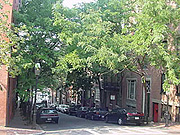
The trees in our urban forest make our communities more liveable, improve the global environment and connect people to nature and each other. Trees beautify our neighborhoods and give them character. They soften harsh city lines and mediocre architecture. They soothe minds, provide recreational opportunities, and improve the quality of our lives. Their shade drops temperatures 10 degrees and increases comfort. It's the difference between 101° F and 91° F.
A Healthy Urban Forest is No Accident!
Trees are an integral part of our living space and offer a multitude of environmental, social, and economic benefits. Urban forestry is about expanding, enhancing and preserving trees in our urban communities.Try this experiment at home
In the heat of the summer, measure the temperature under the shade of a mature tree. Using the same thermometer, measure the temperature in a shadeless area of your property. The difference will be about 10 degrees.Can money grow on trees?
Sometimes money grows on trees, as in cleaner air, increased property values, cooler homes, energy savings, preserved animal habitats, and beautiful streets where people like to visit and shop.And then there are working trees - trees that are strategically planted to address a particular need and do a particular job. Trees that provide windbreaks and reduce wind erosion. Trees that provide visual barriers to screen unsightly areas. Trees that abate sound and decrease noise pollution. Trees that separate urban areas from rural, or residential from commercial. Trees that stabilize a river bank, stem erosion and control floods.
